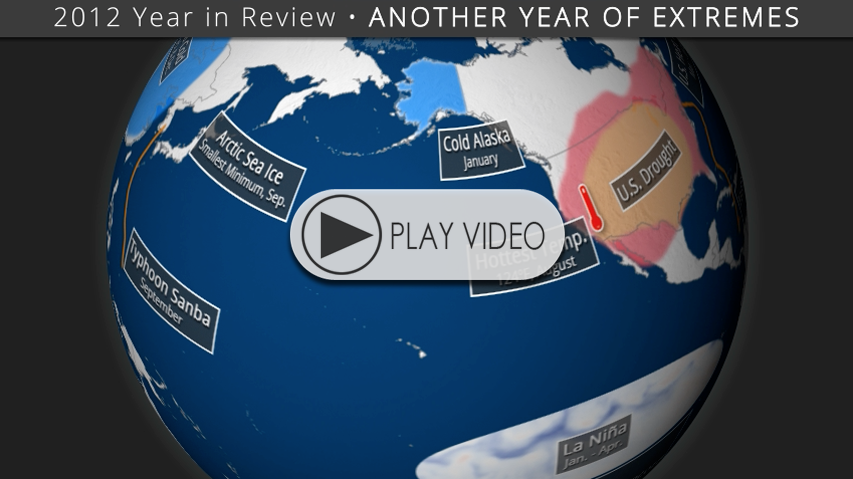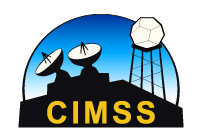SOS Playlists
 SOS Playlist
SOS Playlist
Overview
For this EarthNow entry, we thought it would be nice to do a global review of 2012, with regards to major weather and earth science events, as well as some important climate measurements. The bullet points below will simply tell you about how the dataset works. Below the bullet points, you will find more information regarding the events. For even more information, check out the references at the end. Enjoy!
2012 Year in Review
Dataset Name: 20130205 EarthNow: 2012 Year in Review
 Still Map Image
Still Map Image
- This dataset contains a sequence of 15 frames, or images. The first frame is the “Title Frame.” The next 12 frames contain 1 frame for each month of 2011, with the last two frames being conclusion frames, highlighting all of the events of 2012.
- When you load the dataset, the animation will not start by default, allowing you to step through frame by frame using the remote. You can of course “Play” the animation, during which each frame will last for 10 seconds. These settings can be changed in the playlist setting for the file.
Monthly Highlights
January
- La Niña: Weak to moderate La Niña, held over from 2011, in effect from January through April.
- Alaska Extra Cold: We all know that Alaska can be cold, but the state experienced its coldest January on record in 2012.
- Eurasia Cold: A cold wave affected much of the Eurasian continent from January through February. More than 650 fatalities occurred as a result.
- U.K. Dry: The United Kingdom experienced dry conditions for January through March.
February
- La Niña continues
- Eurasia remains cold
- U.K. remains dry
March
- La Niña continues
- U.K. remains dry
- U.S. Heat Wave: An early-season heat wave affected much of the contiguous United States from March through May.
April
- La Niña continues
- U.S. Heat Wave continues
- U.K. Dry No More: After a dry start to the year, the United Kingdom experienced a wetter than normal rest of the year. By the end of the year, the U.K. had experienced its second wettest year on record, behind 2000.
May
- La Niña transitions into a Neutral phase
- U.S. Heat Wave continues
- U.K. remains wetter than normal
June
- U.K. remains wetter than normal
- Russian Drought: Western Russian and Siberia experienced drought conditions from June through July.
- U.S. Drought Index: The U.S. drought severity index was at 55%, the largest percentage since December 1956.
July
- U.K. remains wetter than normal
- Russian Drought continues
- African Flooding: Western and central Africa experienced severe flooding from July through October. Over 3 million people were affected, destroying crops, homes, and schools. The flooding also resulted in outbreaks of several diseases.
August
- U.K. remains wetter than normal
- African Flooding continues
- Argentina Flooding: Heavy rainfall resulted in flooding in eastern Argentina.
- Hottest Temperature of 2012: The hottest temperature of 2012 occurred on August 17th in Death Valley, California. The temperature was 124˚F (51.1˚C).
September
- U.K. remains wetter than normal
- African Flooding continues
- Coldest Temperature of 2012: The coldest temperature of 2012 occurred on September 15th at the Vostok Antarctic Research Station. The temperature was -119.6˚F (-84.2˚C).
- Arctic Sea Ice Minimum: During the melt season, the Arctic sea ice extent reached its lowest extent on record (since 1979).
- Antarctic Sea Ice Maximum: During the growth season, the Antarctic sea ice extent reached its largest extent on record (since 1979).
- Typhoon Sanba: With maximum winds of 280 km/hr, Typhoon Sanba was the strongest tropical cyclone of 2012. Occurring September 10-19, the storm impacted the Philippines, Japan, and the Korean Peninsula with heavy rains, flooding, and landslides.
- U.S. Drought: By September 2012, over two-thirds of the nation was experiencing drought conditions.
- Pakistan Flooding: Pakistan was impacted by heavy rains and flooding, with over 5 million people affected and 460,000 houses damaged or destroyed.
October
- U.K. remains wetter than normal
- African Flooding continues
- Hurricane Sandy: With maximum winds of 175 km/hr, Hurricane Sandy was the most noted storm for the Atlantic basin in 2012. First impacting the Caribbean and claiming about 80 lives, Sandy then impacted the U.S. eastern seaboard, including a sharp westward turn into the highly populated northeast region, where Sandy resulted in over 130 fatalities.
November
- U.K. remains wetter than normal
- Argentina Flooding: Once again, eastern Argentina experienced heavy rain and flooding for November through December.
December
- U.K. remains wetter than normal
- Argentina flooding continues
- Eurasia Cold: After starting 2012 with extremely cold temperatures, much of the Eurasian region ended 2012 with below normal, record-breaking cold temperatures.
Where do I find the datasets?
-
First, check your SOS system to make sure it’s not already in the EarthNow category.
-
If not, you can download the dataset and playlist files from this FTP Site.
-
Then download and use playlist file(s) at the top of the page (or create your own) and make sure they are in /home/sos/sosrc or /home/sosdemo/sosrc.







